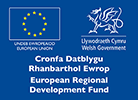In November 2015, Western Refi nery Services (WRS) in Washington State, USA, installed over 2000m² of Concrete Canvas (CC) GCCM. The material was used to provide a protective top-layer to a HDPE liner on a bund at a petroleum storage site. WRS have previously used CC and due to the success of their fi rst installation, did not consider any alternatives. See how this installation was carried out here.
In April 2017, design studio Zeller & Moye began working with Concrete Canvas® GCCM* (CC) as the material of choice for ‘stiff’, which would be exhibited at the Textilmuseum St. Gallen in Vadianstrasse, Switzerland.
Designers Christoph Zeller and Ingrid Moye used a total of 440m2 of CC13TM to produce their design pieces. It took a total of 15 months to produce the furniture, from concept to completion, which were used as tables, plinths and displays, and the backdrop for exhibition pieces in the ‘Neue Stoffe-New Stuff’ exhibition, a survey on technical textiles at the museum.
Click here to find out more about the project, and to find about more about the designers, visit their website here.
In June 2017, CC Hydro™ (CCH) GCCB* was used to provide a waterproof layer to bridge decking on the Old Elvet Bridge in Durham, UK. The Old Elvet Bridge is a Grade I listed mediaeval masonry arch bridge across the River Wear, linking the peninsula in central Durham and the Elvet area of the city. Building of the bridge began in AD 1160, and construction of the arches is believed to have continued into the 13th century, although exactly how many there are is still debated to this day.
An inspection identified that the arch barrels were saturated in localised areas with water staining to most of the arches indicating any waterproofing was not adequate and probably not present at all. If this issue was not addressed the deterioration of the masonry would continue. As a result Durham County Council (DCC) who maintain the bridge required a solution for repairing the bridge deck and preventing water ingress.
Read on to find out just how CC Hydro became the solution here.
In November 2017, Concrete Canvas® GCCM* (CC) was used to line an irrigation channel in Accra, Ghana. The installation was carried out as part of the Ashaiman Irrigation Scheme for the Ghana Irrigation Development Authority.
The client specifically chose CC as the solution for this project in order to determine the material’s advantages over conventional channel lining methods. The client was particularly keen to witness CC’s ability to save time both during installation and post-installation (due to its 24-hour setting time), durability, reduction in labour, and ease of installation.
The works were carried out by De-Montag Company Limited for the Ghana Irrigation Development Authority.
Copper mining is reported to have begun in the Avoca River valley in around 1720 and continued, with interruptions, until 1982. Among the minerals produced in the last two centuries, copper has been primarily mined along with silver and gold, although the latter was mined to a lesser extent. The Avoca river, which flows southwards through the Avoca mine site, is overlooked by upland areas known as the East and West Avoca mine areas.
Mineral extraction has left an environmental legacy that comprises open pits, over 70 shafts and adits, numerous spoil piles and former mine buildings and structures. Water discharges from the abandoned copper and sulphur mines are acidic and metal laden which impacts water quality in the Avoca River.
In June 2017, Concrete Canvas® GCCM* (CC) was used to line a series of drainage channels to divert surface water around a remediated contaminated spoil site at the Avoca Mines in Wicklow, Ireland.
Find out more about this case study, and how CC will help the communities surrounding the Avoca Mining sites, here.
On 7th January 2016, the steep slope overlooking part of the Newcastle to Carlisle rail line between Corbridge and Riding Mill, on the south side of the line, suffered a significant failure, resulting in a landslide which covered the tracks in soil, debris and fallen trees, closing the line. The event occurred following a prolonged period of heavy rainfall, which was reported to be the most exceptional period of rainfall on record for the area, with significant overland flows breaching the existing drainage network at the crest of the cutting slope, triggering the landslide.
The channel installed using CC helped to direct and control drainage on the site, and was specified to be deeper than the original drainage system, in order to ensure it was able to manage the volume of water flowing through it. CC was specified to reduce the risk of any future water ingress into the cutting. The works were carried out by Construction Marine Limited for Network Rail.
To find out more about this installation, click here.
In June 2017, contractor Bam Nuttall installed Concrete Canvas GCCM as part of the Great Western Electrification Projects’ improvements to drainage structures at Fosse Way, near Sherston.
This followed on from the successful installation of the material on a seperate section in 2014, where CC was used to line an open drainage channel to prevent erosion and reduce cutting saturation, potentially causing land slippage. Since 2014, downstream of the CC installation and beyond a culverted section of drainage, an unlined section of the channel had eroded away. This resulted in a 3m deep scour pocket occurring as water discharged from a headwall into the unlined channel.
Find out how CC was used to solve the problem on this second section of the site click here.
Jones Bros Civil Engineering have published a press release detailing their use of CC as part of a £22m Welsh Government project to improve safety and reduce the flooding risk on a 2.2km stretch of the A55 between the Tai’r Meibion property and the Abergwyngregyn interchange. View the complete article here.

